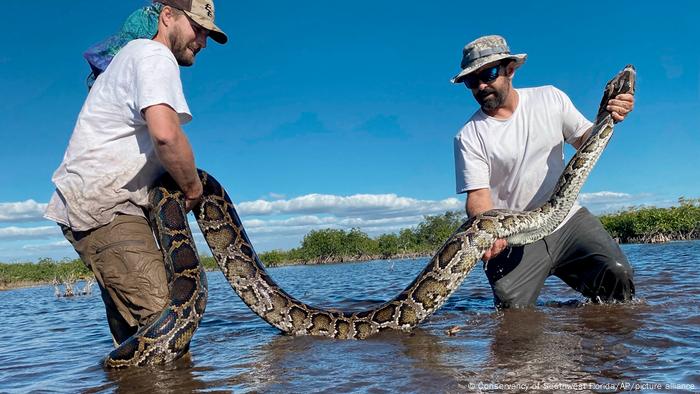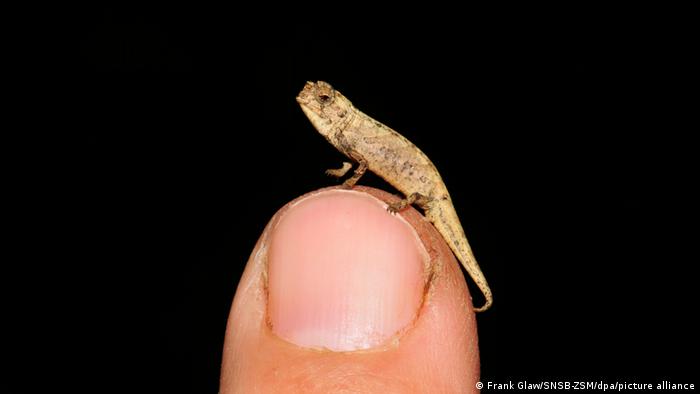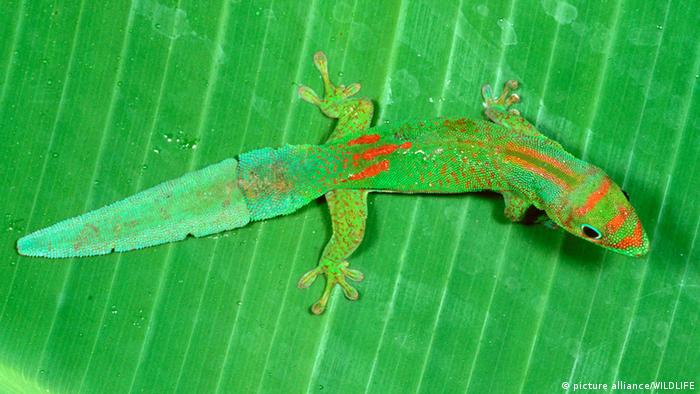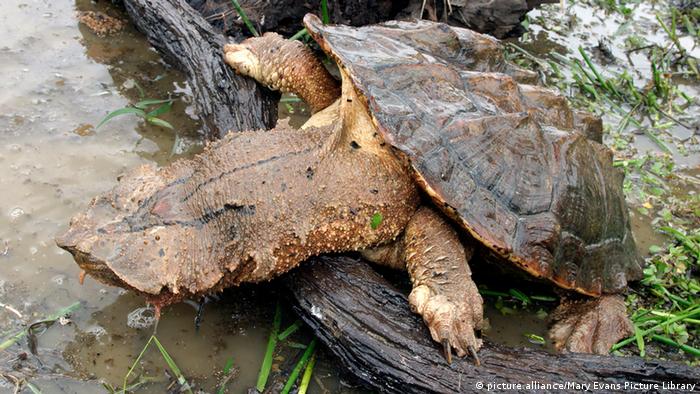A 18-foot Burmese python recently discovered in the US state contained 122 eggs. The introduced constrictor threatens the unstable ecosystem in Everglades National Park.

Male snakes with tracking devices guide the biologists to the reproductive females
Florida has had a major snake problem for years. But how enormous this problem has become was illustrated recently by a record-breaking Burmese python that biologists caught in Everglades National Park.
The 5.5-meter-long female weighed 98 kilograms. “We documented 122 eggs in this snake,” said biologist Ian Bartoszek of the Southwest Florida Cooperative Invasive Species Management Area (CISMA). “An average clutch has 43 eggs. Imagine that: 122 eggs that mature inside,” Bartoszek said in a press conference.
The swampy marshland of the Everglades with its hot and humid climate offers ideal living conditions for the introduced snake species, which has multiplied and spread explosively in recent years and which, apart from humans, has no natural enemies there.
Ideal living conditions for former pet
Originally, this invasive snake species does not belong in Florida. The Burmese Python (Python bivittatus) is native to various countries in Southeast Asia, from Northeast India to southern China. In the 20th century, the constrictor snake was introduced to the USA as a “pet” and also bred there. The first specimens appeared in the Everglades from the 1970s.

The swampy marshland offers ideal living conditions for the introduced snake species
It is unclear whether the first specimens escaped from breeding facilities or were abandoned by owners when the animals became too large for them. In addition, Hurricane Andrew destroyed a snake farm in 1992, and more than 1,000 animals escaped into the vast swamplands of the Everglades. Biologist Bartoszek suspects that the giant python found now comes from a pet husbandry and was released decades ago.
Conservationists hunt female pythons
For almost ten years, the CISMA conservationists have been hunting female pythons in order to interrupt the breeding cycle. The biologists use male snakes as decoys. They are equipped with a transmitter and guide the conservationists through the dense undergrowth to brood accumulations with large, reproductive females.
The huge Burmese python that has now been discovered was also found using a tracking transmitter, which the male Dion was wearing. The giant python was then put down.
A success for the conservationists, so far the biologists have been able to capture more than 1000 animals, but considering the large number of eggs, this hunt is an extremely uphill battle.

Collecting the large female python is a race against time
What was once thought to be a cute pet now poses a massive threat to native wildlife in the Everglades' fragile ecosystem. “These animals are big game hunters, as you can imagine from their size,” says Bartoszek. “They can take down prey that is quite large.”
The stranglers are not particularly choosy when it comes to the choice of food. The populations of native mammals such as rabbits, possums, raccoons, opossums and white-tailed deer have now been almost wiped out by the python plague.
A python caught in December had just eaten an adult white-tailed deer – the biologists found in the snake's stomach the corresponding deer hooves during the autopsy.
Native predators are also seriously threatened by the pythons. Rabbits, possums and white-tailed deer also feed on the endangered native Florida panther, for which the pythons are now a serious competitor.
-
 The reptile cabinet of curiosities
The reptile cabinet of curiosities
The smallest sensation
Brookesia nana is the name of the smallest known reptile in the world, which became known in January 2021. Due to its tiny length of 13.5 to 19 millimeters and its brown colour, it is hardly noticeable on the forest floor. The tiny chameleon lives in a remote northern part of Madagascar. So far, this mini reptile has been a loner. It has not been possible to find further specimens of the new species.
-
 The Reptilian Cabinet of Curiosities
The Reptilian Cabinet of Curiosities
Animal Camouflage
Well, where is the mini lizard? With its green color, this small, grass-green day gecko hardly stands out from the leaf. This genus has no eyelids. Over the course of evolution, the upper and lower lids have grown together to form a transparent membrane. These diurnal animals are mostly encountered on the islands of the Indian Ocean or Madagascar.
-
 The reptile cabinet of curiosities
The reptile cabinet of curiosities
Please do not touch!
This lizard lives up to its name: its entire body is covered with thorns. The Thorny Devil Lizard is native to Australia. It is well adapted to life in the dry, because the grooves on the body transport rain and condensation water directly into the mouth.
-
 The reptile cabinet of curiosities
The reptile cabinet of curiosities
Not my collar size!
The frilled lizard tries to communicate this when it raises its flaps of skin on its neck. This threatens her predators or rivals. The neck brace has a diameter of up to 30 centimetres. Frilled lizards belong to the Agama family. They live exclusively in Australia and New Guinea.
-
 The cabinet of curiosities of the Reptiles
The cabinet of curiosities of the Reptiles
Colorful Longnose
Another representative from the species-rich Madagascar: Panther chameleons are among the most colorful of their kind. The color spectrum ranges from gray to green to pink and purple. The crest running over the entire back and ending in an extension of the nose is characteristic.
-
 The reptile cabinet of curiosities
The reptile cabinet of curiosities
Dwarf Triceratops
The three-horned chameleon is slightly smaller than its dinosaur counterpart. With a body length of 38 centimetres, the males of this species are significantly larger than many of its relatives. The three-horned chameleon is native to the mountain rainforests of East Africa.
-
 The cabinet of curiosities of reptiles
The cabinet of curiosities of reptiles
algae divers on Galapagos
A truly good diver is the marine iguana on the Galapagos Islands. They search for food under water for up to 30 minutes. Her heartbeat slows to ten beats per minute. Their skin is usually dark so that it warms up as quickly as possible after a bath in cold water.
-
 The Reptilian Cabinet of Curiosities
The Reptilian Cabinet of Curiosities
Giant Dragon
The largest living lizard weighs up to 70 kilograms! Even deer and wild boar are not too big for the Komodo dragon to prey on. Its secret weapon is toxic saliva, which reduces blood clotting and can lead to shock. The Komodo dragon lives exclusively on smaller islands in Indonesia.
-
 The cabinet of curiosities the reptile
The cabinet of curiosities the reptile
Green streamer
The green tree python likes to live with a view. The snake wraps itself around branches at a height of up to 25 meters. Hidden like this, she lurks for potential prey. The striking green animals live in northern Australia and New Guinea.
 The reptile cabinet of curiosities
The reptile cabinet of curiosities
Small head with a big impact
An impressive example, just like the outward appearance can deceive. The skin in the egg snake's jaw area is three to four times stretchable. The snake, which is just as thick as a thumb, can even eat chicken eggs. Only farmers in sub-Saharan Africa, where the egg snake hunts prey, have to worry.
-
 The reptiles' cabinet of curiosities
The reptiles' cabinet of curiosities
Brilliantly bizarre!
At first glance, the look of this fringed turtle seems anything but intended. But the eponymous fringes on the body are ingenious: they make the turtle, which lives in the fresh water of South America, appear almost invisible under water. Every chameleon would green with envy!
Author: Valentin Betz



 The reptile cabinet of curiosities
The reptile cabinet of curiosities The Reptilian Cabinet of Curiosities
The Reptilian Cabinet of Curiosities The reptile cabinet of curiosities
The reptile cabinet of curiosities The reptile cabinet of curiosities
The reptile cabinet of curiosities The cabinet of curiosities of the Reptiles
The cabinet of curiosities of the Reptiles The reptile cabinet of curiosities
The reptile cabinet of curiosities The cabinet of curiosities of reptiles
The cabinet of curiosities of reptiles The Reptilian Cabinet of Curiosities
The Reptilian Cabinet of Curiosities The cabinet of curiosities the reptile
The cabinet of curiosities the reptile The reptile cabinet of curiosities
The reptile cabinet of curiosities The reptiles' cabinet of curiosities
The reptiles' cabinet of curiosities